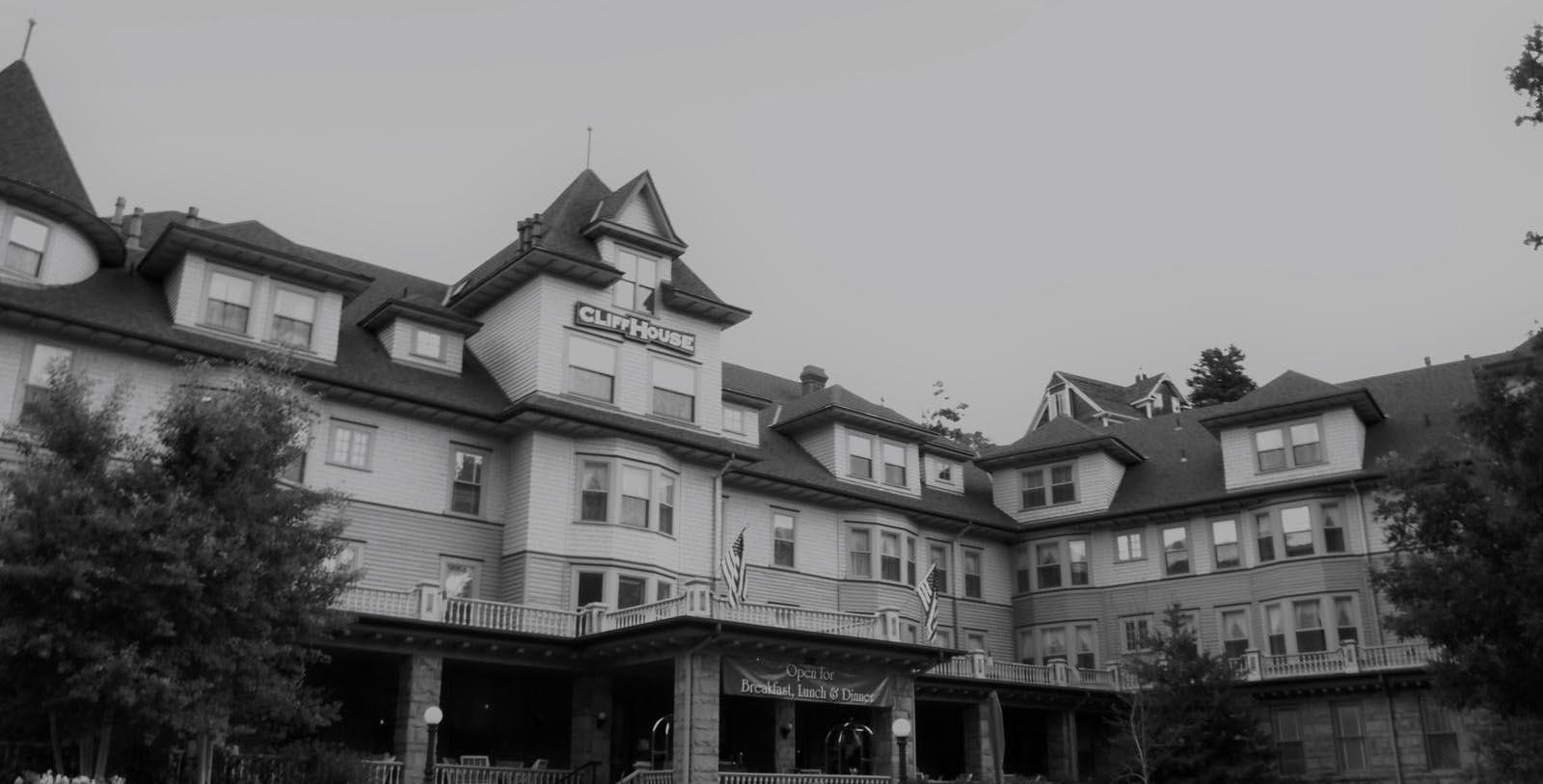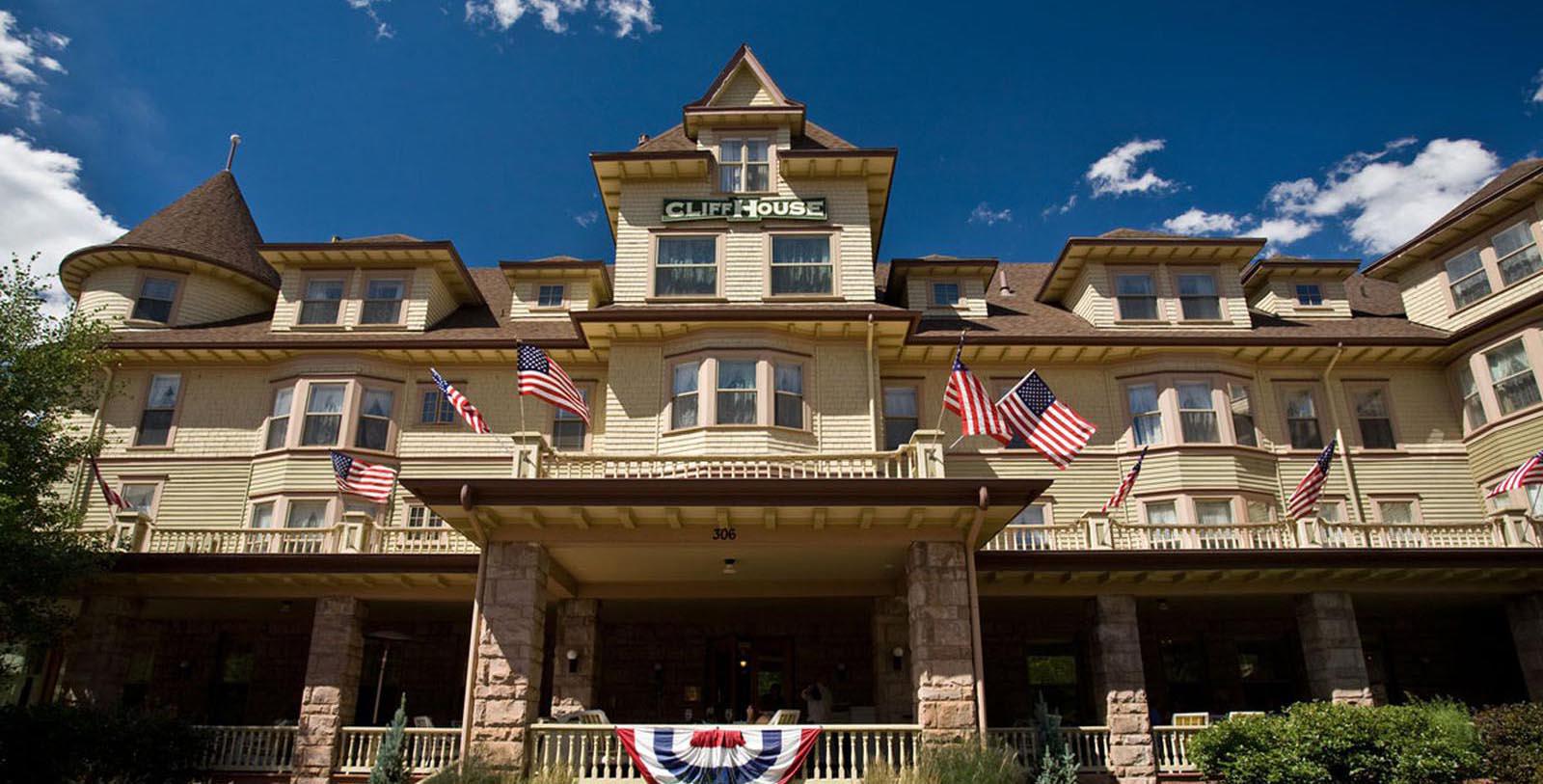Receive for Free - Discover & Explore eNewsletter monthly with advance notice of special offers, packages, and insider savings from 10% - 30% off Best Available Rates at selected hotels.
history
Discover The Cliff House at Pikes Peak, which has been offering prime access to the anicent mineral waters of Manitou Springs since the 19th century.
The Cliff House at Pikes Peak, a member of Historic Hotels of America since 2001, dates back to 1873.
VIEW TIMELINEListed on the National Register of Historic Places, the Cliff House at Pikes Peak is among the most historic holiday destinations in Colorado. In fact, the Cliff House has been open longer than Colorado has been a state! Built in the winter of 1873, the structure originally debuted a year later as a 20-room boarding house known simply as “The Inn.” It specifically operated as a stagecoach stop along one of the earliest routes that connected Colorado Springs to Leadville, which was one of the most famous stagecoach runs of the American West. Even the earliest guests—mostly trappers and hunters—were drawn to its inviting parlors and rambling porches. There were times when tents had to be pitched next to the building to accommodate the overflow of guests. But when the gold strikes in the Pikes Peak region began to play out, travel through the region dwindled significantly. As such, The Inn struggled to fill its vacant guestrooms. Fortunately, over the next half-dozen years, interest in the town’s ancient mineral springs had increased dramatically, thanks to the efforts Dr. William Abraham Bell and General William Jackson Palmer. For thousands of years, the springs had bubbled up from underground limestone aquifers that carbonated the water and infused it with minerals. The water was temperate, good-tasting, and had a high concentration of minerals that benefited the body. As such, Bell and Palmer created a town around the mineral springs that they hoped would become a world-renowned resort community. Yet, the men also saw their nascent settlement as a refuge for those suffering from illness, believing the water to possess mystical healing properties. Thus the two partners founded “Manitou Springs” just to the west of Colorado Springs.
At the same time, Edward E. Nichols headed to the region to fight his personal battle with tuberculosis. Nichols successfully conquered the disease, convinced that the mineral springs had given him the strength to prevail. He soon rose in prominence in the new town of Manitou Springs, even serving as its mayor for eight terms. In 1886, Nicholas purchased The Inn and renamed it as “The Cliff House.” He immediately began converting it into a sophisticated resort hotel that capitalized on the sparking waters of the area. Nicholas also collaborated with future Colorado Governor Oliver Henry Nelson Shoup to found the Manitou Bath House Company. The new enterprise introduced a surge of new business into Manitou Springs, successfully attracting an increasingly number of guests to The Cliff House. To adequately meet the demand for available accommodations, Nichols expanded the hotel from 20 guestrooms to 56, and eventually all the way up to 200. The result was the beautiful, four-and-a-half story building that still stands today. The Cliff House even became a prime vacation destination for some of the most influential individuals of the age, including the likes of inventor Thomas Edison, showman P.T. Barnum, Archduke Franz Ferdinand of Austria, and President Theodore Roosevelt. All guests of The Cliff House received the personalized attention expected at a premier resort hotel. And in later years, a bathhouse was built at the spa and bell boys would fill bottles with the sparkling spring water for the guests to try. The Cliff House at Pikes Peak soon became the most popular hotel and spa in the Colorado Springs region, drawing people from all walks of life and from around the world. Now known as “The Cliff House at Pikes Peak,” this wonderful historic destination continues to attract people from all across the world.
-
About the Location +
People have known about the Manitou Mineral Springs for generations, as its mineral springs have attracted curious travelers over millennia. In fact, legend has it that the Ute once inhabited the region during the winter months many years ago. They did so due to the springs’ alleged medicinal healing properties, which repaired the body and rejuvenated the soul. (The Utes also felt that the water was spiritual, as the bubbles generated within the mineral springs were considered to have come from the “Great Spirit Manitou” itself.) Many other Native American people also arrived as well, including the likes of the Apache and the Cheyenne. European Americans first learned of the location from the tales of famous explorers who roamed the western plains at the start of the 19th century. Historians today credit Stephen Harriman Long and his team as being the first Americans to set eyes on the mineral springs, with Dr. Edwin James—the group’s resident botanist—stumbling upon the boiling body of water in 1820. Soon enough, adventurers from across the globe followed up on Dr. James’ account. English explorer George Frederick Ruxton would even write about his personal experiences at the site in his popular book, Life in the Far West. But in the 1870s, Dr. William Abraham Bell and William Jackson Palmer—a Civil War general—decided to establish a health resort in the area, inspired by the stories they had heard regarding its mystical abilities. Having watched the neighboring community of Colorado Springs successfully emerge a decade prior, the two endeavored to create their own brilliant retreat around the Manitou Mineral Springs. They specifically envisioned the town to contain nothing than season villas and grand hotels, clustered around several landscaped parks as well as the mineral springs.
Palmer soon teamed together with Henry McAllister to advertise the supposed medical benefits of the Manitou Springs, even going as far as to declare that the region had “incomparable climate and scenery.” Enterprising hoteliers soon arrived in the town, creating several outstanding hotels and inns. Those suffering from various ailments quickly flocked to the location, driven by Palmer and McAllister’s statements. But many other people came to the fledgling community—eventually called “Manitou Springs” after the wells themselves—such as merchants, farmers, and ordinary families. Much to the dismay of Bell and Palmer, those individuals constructed all kinds of residences and storefronts with the latest Victorians architectural styles, giving the town its rustic, historical charm that still persists today. Yet, Manitou Springs continued to operate as a dual resort community and health spa. Medical practitioners across the nation kept endorsing the views expressed by the town’s founders, with Dr. Edwin Solly taking the most adamant approach. He specifically championed Manitou Springs as a great destination for those suffering from tuberculosis, considering the well water perfect for the infirm. As such, local businesspeople began drilling their own wells to access the Manitou Springs, with around 50 active by the 1890s. Some of the wells were even enclosed in special houses, producing a unique landscape for the community. Among the most noteworthy were the 7 Minute Spring, the Cheyenne Spring House, and the Shoshone Spring. (Some of the structures are currently listed on the U.S. National Register of Historic Places.)
Over time, Manitou Springs developed a reputation as an exclusive vacation hotspot, as guests increasingly yearned to visit the cultural attractions scattered across the region. Most of the locations consisted of grand natural wonders, such as the Rainbow Falls, Garden of the Gods, and Cave of the Winds. The historic Manitou and Pikes Peak COG Railway ferried people across the countryside as well, which provided one of the most memorable experiences. But the town’s legendary spring water remained central to the identity of Manitou Springs. Jerome Wheeler—a former president of Macy’s Department Store—even constructed a three-story bottling plant in order to share the mineral springs with people all over the United States. Today, Manitou Springs continues to be one of the most exciting places to vacation in Colorado. It proudly embraces its historical past, offering tours of its historic mineral springs to all who are interested in learning more. Manitou Springs is also home to numerous cultural attractions, such as Miramont Castle Museum, the Manitou Springs Heritage Center, and the Manitou Cliff Dwellings. Much of the town is preserved as the “Manitou Springs Historic District,” which is one of the largest of its kind in the entire United States. Truly few places are better in the vicinity of the famed Colorado Rockies for a historically-themed trip than Manitou Springs.
-
About the Architecture +
The Cliff House at Pikes Peak displays some of the finest Queen Anne-style architecture in the state of Colorado. Considered a successor to Eastlake architecture, Queen Anne became a widely popular architectural style at the height of the Gilded Age. Named in honor of the 18th-century British monarch, Queen Anne, the architectural form started in England before migrating to the United States. Yet, its name is misleading, as it actually borrowed its design principles from buildings constructed during the Renaissance. While the appearance of Queen Anne-style buildings may differ considerably, they are all united by several common features. For instance, they are typically asymmetrical in nature, and are built with some combination of stone, brick, and wood. Those buildings also feature a large wrap-around porch, as well as a couple polygonal towers. Those towers may also be accompanied by turrets along the corners of a building’s exterior façade. And like Shingle-style architecture, structures designed with Queen Anne-style design principles may also have pitched, gabled roofs that feature irregular shapes and patterns. Intricate wood carvings are a common sight throughout their layout, too, and are often designed in such a way to resemble different objects. As such, guests viewing the architectural features of Queen Anne architecture many feel as if they had been staring at an illusion! Clapboard paneling and half-timbering are a few other forms of woodworking that are regularly found somewhere within a Queen Anne-style structure. Nonetheless, the innate aspects of the hotel’s brilliant Queen Anne architecture blends seamlessly with its Shingle-style aesthetics, giving it a rare, beautiful appearance.
-
Famous Historic Guests +
William Henry Jackson, explorer and photographer remembered for his images of the American West.
F.W. Woolworth, founder of the F.W. Woolworth Company and an innovator of the modern retail market.
J. Paul Getty, founder of the Getty Oil Company.
Charles Dickens, Jr., author and first-born son of the famous English novelist, Charles Dickens.
P.T. Barnum, showman best remembered for founding the famous “Barnum & Bailey Circus.”
Thomas Edison, inventor known for such inventions as the motion picture camera and the lightbulb.
Clark Gable, actor known for his roles in It Happened One Night, Mutiny on the Bounty, Gone with the Wind.
Archduke Franz Ferdinand, Crown Prince of Austria
Theodore Roosevelt, 26th President of the United States (1901 – 1909)































